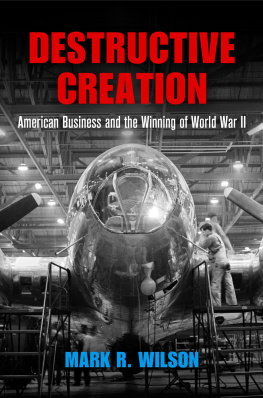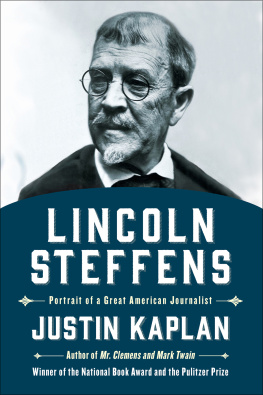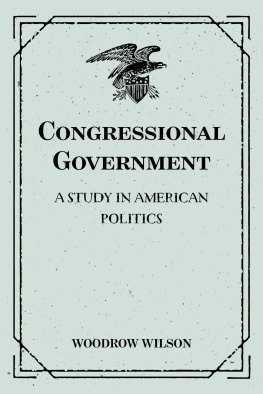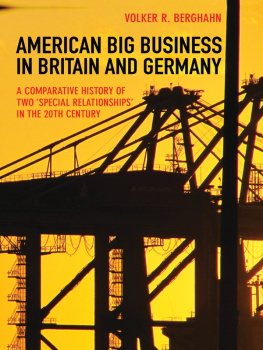Mark R. Wilson - Destructive Creation: American Business and the Winning of World War II (American Business, Politics, and Society)
Here you can read online Mark R. Wilson - Destructive Creation: American Business and the Winning of World War II (American Business, Politics, and Society) full text of the book (entire story) in english for free. Download pdf and epub, get meaning, cover and reviews about this ebook. year: 2016, publisher: University of Pennsylvania Press, Inc., genre: Politics. Description of the work, (preface) as well as reviews are available. Best literature library LitArk.com created for fans of good reading and offers a wide selection of genres:
Romance novel
Science fiction
Adventure
Detective
Science
History
Home and family
Prose
Art
Politics
Computer
Non-fiction
Religion
Business
Children
Humor
Choose a favorite category and find really read worthwhile books. Enjoy immersion in the world of imagination, feel the emotions of the characters or learn something new for yourself, make an fascinating discovery.
- Book:Destructive Creation: American Business and the Winning of World War II (American Business, Politics, and Society)
- Author:
- Publisher:University of Pennsylvania Press, Inc.
- Genre:
- Year:2016
- Rating:5 / 5
- Favourites:Add to favourites
- Your mark:
- 100
- 1
- 2
- 3
- 4
- 5
Destructive Creation: American Business and the Winning of World War II (American Business, Politics, and Society): summary, description and annotation
We offer to read an annotation, description, summary or preface (depends on what the author of the book "Destructive Creation: American Business and the Winning of World War II (American Business, Politics, and Society)" wrote himself). If you haven't found the necessary information about the book — write in the comments, we will try to find it.
Mark R. Wilson: author's other books
Who wrote Destructive Creation: American Business and the Winning of World War II (American Business, Politics, and Society)? Find out the surname, the name of the author of the book and a list of all author's works by series.
Destructive Creation: American Business and the Winning of World War II (American Business, Politics, and Society) — read online for free the complete book (whole text) full work
Below is the text of the book, divided by pages. System saving the place of the last page read, allows you to conveniently read the book "Destructive Creation: American Business and the Winning of World War II (American Business, Politics, and Society)" online for free, without having to search again every time where you left off. Put a bookmark, and you can go to the page where you finished reading at any time.
Font size:
Interval:
Bookmark:

Destructive Creation
AMERICAN BUSINESS, POLITICS, AND SOCIETY
Series editors
Andrew Wender Cohen, Pamela Walker Laird, Mark H. Rose, and Elizabeth Tandy Shermer
Books in the series American Business, Politics, and Society explore the relationships over time between governmental institutions and the creation and performance of markets, firms, and industries large and small. The central theme of this series is that politics, law, and public policyunderstood broadly to embrace not only lawmaking but also the structuring presence of governmental institutionshave been fundamental to the evolution of American business from the colonial era to the present. The series aims to explore, in particular, developments that have enduring consequences.
Destructive Creation

American Business and the Winning of World War II
Mark R. Wilson
PENN
UNIVERSITY OF PENNSYLVANIA PRESS
PHILADELPHIA
Copyright 2016 University of Pennsylvania Press
All rights reserved.
Except for brief quotations used for purposes of review or scholarly citation,
none of this book may be reproduced in any form by any means
without written permission from the publisher.
Published by
University of Pennsylvania Press
Philadelphia, Pennsylvania 191041-4112
www.upenn.edu/pennpress
Printed in the United States of America
on acid-free paper
1 3 5 7 9 10 8 6 4 2
A Cataloging-in-Publication record is available from the Library of Congress
ISBN 978-0-8122-4833-3
For Christine
Contents
Introduction
World War II was won not just by brave soldiers and sailors but also by mountains of matriel. This was true even in times and places where guts were at a premium, as during the Allied invasion of Normandy, in June 1944. On D-Day and in the days that followed, American GIs and their British and Canadian counterparts were sometimes disappointed (and killed) by their own machines, too many of which sank below the waves, missed their targets, or otherwise failed to work as advertised. Even so, the soldiers preparing to land on the Normandy beaches could not help but be overawedand deafenedby the firepower assembled to support them. In the skies just ahead, they saw hundreds of military aircraft, which, on the morning of 6 June alone, dropped thousands of high-explosive bombs. Behind them in the English Channel floated more than a hundred hulking warships, their big guns close to overheating from their constant shelling of German positions on the shore. Along with the naval vessels, the soldiers could also see a fleet of hundreds of cargo ships and landing craft, stretching to the horizon. These vessels, by the end of the two weeks starting with D-Day, would deliver to the Normandy beaches nearly 94,000 vehicles and over 245,000 tons of equipment and supplies, along with nearly 620,000 men. Here was the beginning of the end for the German armies, which, in the weeks to come, would be overwhelmed by the speed and power of Allied forces.
D-Day was truly an Allied operation, in which Britain (and Canada) provided much of the equipment and manpower. Yet even in a battle that took place just a hundred miles from England, one of the worlds great industrial nations, it was obvious how much the Allied war effort depended on the economic output of the United States. The skies above Normandy buzzed with the bombers of the Eighth Air Force and Ninth Air Force: B-17 Flying Fortresses, B-24 Liberators, and B-26 Marauders (among other aircraft), made in Seattle, San Diego, and Baltimore. Many of the GIs who struggled ashore at Omaha Beach owed their lives to the sailors manning
Normandy was an exceptional military operation, but its reliance on American-made machines and matriel was part of a broader pattern of Allied war-fighting. During World War II, the United States helped vanquish the Axis powers by converting its enormous economic capacities into military power. By producing nearly two-thirds of all the munitions used by Allied forcesincluding huge numbers of aircraft, ships, tanks, trucks, rifles, artillery shells, and bombsAmerican industry became what President Franklin D. Roosevelt once called the arsenal of democracy, providing the foundations for a decisive victory.
So the U.S. military-industrial mobilization for World War II worked well, or at least well enough. But how exactly did it work? How were all those bombers, ships, and planes produced, in such short order, under the pressures of a war emergency? And how was the mobilization related to broader, longer-run political and economic developments? What lessons should we take from its history? Seven decades after the end of World War II, we still lack good answers to these questions.
Since the 1940s, most accounts of the U.S. industrial mobilization for World War II have emphasized one of two stories.
Despite their differences, these two accounts share a tendency to ignore, or disdain, the role of the public sector, including the work of the men and women who staffed powerful military and civilian governmental agencies. In the stories that celebrate the wartime achievements of American capitalism, the main characters are for-profit firms and their executives, some of whom took temporary jobs in government to help win the war. These same executives also figure prominently, albeit as villains, in the anticorporate version of events. That story is ultimately no less disparaging of civilian governmental and military authorities, because most of those public officials are presented as the handmaidens of big business.
This book shows that the military-industrial juggernaut of the early 1940s relied heavily on public investment, public management of industrial supply chains, and robust regulation. These powerful state actions shaped the dynamics of political struggle on the World War II home front. Wartime government-business relations were often antagonistic. Many business leaders regarded the wartime state as an annoyance: an imposing, overreaching regulator, as well as a threatening rival. They said so, openly, throughout the war. Their protests included aggressive, coordinated public-relations efforts, which played up the achievements of the private sector while dismissing the value of public contributions to the war economy. This pro-business framing effort was never uncontested, but it proved remarkably successful during World War IIand long after.
This book builds on a third, loosely woven and overlooked set of studies, which have called attention to the importance of public finance, military administration, and government enterprise on the American home front. But it also describes the work of less familiar individuals and agencies, such as the Army Air Forces Materiel Command (based at Wright Field, in Ohio); military price adjustment boards; and plant seizure teams, led by career military officers such as Admiral Harold G. Bowen. It also considers a variety of important war contractors, including midsize and larger companies in several industries, along with some of the eras most politically active business executives. Many of the latter, including Frederick C. Crawford and J. Howard Pew, joined the ranks of top military contractors in the early 1940s, despite their deep distrust of the federal government.
Following the activities of this diverse cast of characters, this book weaves together two stories about destructive creation. During the early part of World War II, the economist Joseph Schumpeter coined the phrase creative destruction to refer to the dynamism of capitalist economies, in which entrepreneurs created economic growth, even as they caused painful disruptions. Schumpeter did not use the phrase to refer specifically to the U.S. war mobilization, about which he knew little. But he presented it at a moment in which the U.S. economy was being transformed into a generator of devastating military power. Here was what might be called a destructive creation, in which a giant capitalist economy was harnessed for the purpose of annihilating its enemies.
Next pageFont size:
Interval:
Bookmark:
Similar books «Destructive Creation: American Business and the Winning of World War II (American Business, Politics, and Society)»
Look at similar books to Destructive Creation: American Business and the Winning of World War II (American Business, Politics, and Society). We have selected literature similar in name and meaning in the hope of providing readers with more options to find new, interesting, not yet read works.
Discussion, reviews of the book Destructive Creation: American Business and the Winning of World War II (American Business, Politics, and Society) and just readers' own opinions. Leave your comments, write what you think about the work, its meaning or the main characters. Specify what exactly you liked and what you didn't like, and why you think so.








